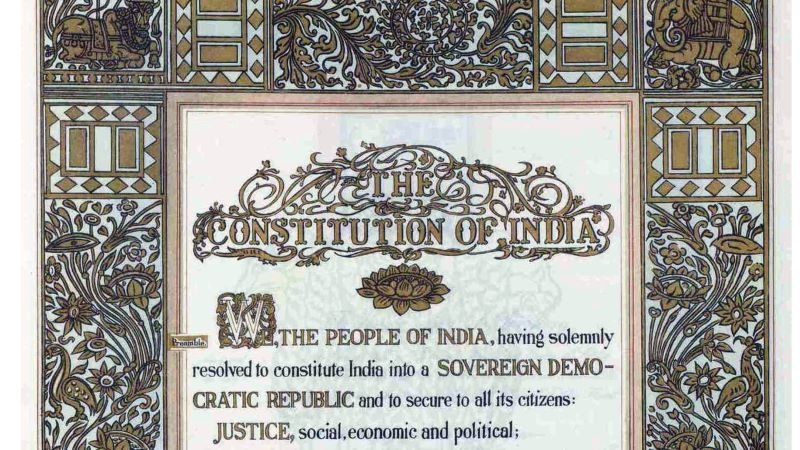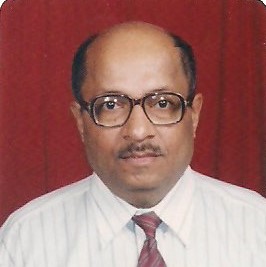Demolish the last remnant of the ‘black days’ of the yesteryear

India's Constitution: The Original Preamble
The preamble is defined as “an introduction to a speech or piece of writing and something that happens before or leads to something else”. In the context of international affairs preamble is considered as an agreement between the warring parties to talk maybe a preamble to peace.
The preamble of the Indian Constitution: The Preamble, and indeed the Constitution, was drafted in the light and direction of the Objective Resolutions adopted on January 22, 1947, which runs as follows: (1) THIS CONSTITUENT ASSEMBLY declares it's firm and solemn resolve to proclaim India as the Independent Sovereign Republic and to draw up for her future governance a Constitution. (2) Wherein the territories that now comprise British India, the territories that now form the Indian States, and such other parts of India as are outside British India and the States, as well as such other territories as are willing to be constituted into the Independent Sovereign India, shall be a Union of them all; and (3) Wherein the said territories, whether with their present boundaries or with such others as may be determined by the Constituent Assembly and thereafter according to the law of the Constitution, shall possess and retain the status of autonomous units, together with residuary powers, and exercise all powers and functions of government and administration, save and except such powers and functions as are vested in of assigned to the Union, or as are inherent or implied in the Union or resulting therefrom; and, (4) Wherein all power and authority of the Sovereign Independent India, its constituent parts and organs of government, are derived from the people; and (5) Wherein shall be guaranteed and secured to all people of India justice, social, economic and political; equality of status, of opportunity, and before the law; freedom of thought, expression, belief, faith, worship, vocation, association and action, subject to law and public morality; and (6) Wherein adequate safeguards shall be provided for minorities backward and tribal areas, and depressed and other backward classes; and (7) Whereby shall be maintained the integrity of the territory of the Republic and its sovereign rights on land, sea, and air according to justice and the law of civilized nations, and (8) This ancient land attains its rightful and honored place in the world and makes its full and willing contribution to the promotion of world peace and the welfare of mankind. This type of appeal kept the social emotions under check on the part of the music-makers.
The preamble to the Constitution of India is a brief introductory statement that sets out guidelines, which guides the people of the nation, and to present the principles of the Constitution, and to indicate the source from which the document derives its authority, and meaning. The hopes and aspirations of the people are described in it.
We cannot ignore the presence and contribution of the stalwarts like Dr. Babu Rajendra Prasad, Jawaharlal Nehru, first Prime Minister of India, Sardar Vallabhbhai Patel, first Deputy Prime Minister and Home Minister, J. B. Kriplani, President of Indian National Congress at the time of independence, Maulana Abul Kalam Azad, Minister for Education, Sheikh Abdullah, Syed Amjad Ali, Dr. B. R. Ambedkar, Madhav Shrihari Aney, Frank Anthony, Asaf Ali, N. Gopalaswami Ayyangar, K. M. Munshi, B. N. Rau, Gokulbhai Bhatt, Bhubanananda Das, Brajlal Biyani, Gopinath Bordoloi, Basanta Kumar Das, Biswanath Das, Seth Govind Das, Jairamdas Daulatram, Shankarrao Deo, Gopaldas Ambaidas Desai, Durgabai Deshmukh, Panjabrao Deshmukh, S. K. Dey, Dharam Dass, Acharya Dada Dharmadhikari, Raghunath Vinayak Dhulekar, R. R. Diwakar, Feroze Gandhi, Samaldas Gandhi, Ramnath Goenka, K. Hanumanthaiah, Jaisukh Lal Hathi, M. R. Jayakar, Keshavrao Jedhe, Dr. Narayan Bhaskar Khare, Rafi Ahmed Kidwai, Sucheta Kripalani, V. T. Krishnamachari, Alladi Krishnaswamy Iyer, Ratnappa Kumbhar, H. N. Kunzru, Minoo Masani, Dr. Syama Prasad Mukherjee, S. Nijalingappa, Govind Ballabh Pant, Hari Vinayak Pataskar, S. K. Patil , Sarvepalli Radhakrishnan, C. Rajagopalachari , Ram Sahai Tiwary, Babu Jagjivan Ram, N. G. Ranga , Mahavir Tyagi and several others contributed the Constituent Assembly by their erudite and meaningful deliberations.
Respect for the nation on the part of these stalwarts was beyond doubt and their wisdom and loyalty towards the nation was unquestionable. There is no doubt that these patriots must have given full thought while choosing the terms – ‘sovereign, democratic, republic’, nothing more and nothing less. The act of amendment to the term preamble in 1976 by way of 42nd amendment was a sort of insult to their erudite support. The group which ruled the House and deliberations in 1947-48 as intellectually far ahead of the group which had captured the House in 1976 when the amendment was carried. What happened on the day of the introduction of the 42nd Amendment Bill on the floor of the House was a disastrous and unconstitutional act. That was no parliamentary amendment at all.
The Drafting Committee had seven members: Alladi Krishnaswami Ayyar, N. Gopalaswami; Dr. B. R. Ambedkar, K. M. Munshi, Mohammad Saadulla, B. L. Mitter and D. P. Khaitan. Dr. B. R. Ambedkar was the Chairman of the drafting committee. All these personalities were eminent jurists, doctors, lawyers, social workers, and freedom fighters.
The preamble gives an idea about the following: (1) the source of the constitution, (2) the nature of Indian state (3) a statement of its objectives, and (4) the date of its adoption.
The draft Preamble was considered by the Assembly on October 17, 1949. Shiva Rao observed that "the object of putting the Preamble last, the President of the Assembly explained, was to see that it was in conformity with the Constitution as accepted. "Once the transfer of power had taken place the question of British Parliament's subsequent approval which was visualized in the British Cabinet Commission's original plan of May 1946 could no longer arise. The sovereign character of the Constituent Assembly thus became automatic with the rapid march of events without any controversy, and the words in the Preamble "give to ourselves this Constitution" became appropriate. The Preamble was adopted by the Assembly without any alteration. Subsequently, the words and figure "this twenty-sixth day of November 1949" was introduced in the last paragraph to indicate the date on which the Constitution was finally adopted by the Constituent Assembly.
The preamble that was drafted by the Drafting Committee under the Chairmanship of Dr. B. R. Ambedkar read as follows:
“WE, THE PEOPLE OF INDIA, having solemnly resolved to constitute India into a SOVEREIGN, DEMOCRATIC, REPUBLIC and to secure to all its citizens
JUSTICE, social, economic and political;
LIBERTY of thought, expression, belief, faith, and worship;
EQUALITY of status and of opportunity;
and to promote among them all FRATERNITY
assuring the dignity of the individual and the unity and integrity of the Nation;
IN OUR CONSTITUENT ASSEMBLY this 26th day of November 1949, do HEREBY ADOPT, ENACT AND GIVE TO OURSELVES THIS CONSTITUTION.”
The preamble is based on the objectives of Objectives which was drafted and moved in the Constituent Assembly by Jawaharlal Nehru on 13 December 1946. B. R. Ambedkar said about the preamble: -
“It was, indeed, a way of life, which recognizes liberty, equality, and fraternity as the principles of life and which cannot be divorced from each other: Liberty cannot be divorced from equality; equality cannot be divorced from liberty. Nor can liberty and equality be divorced from fraternity. Without equality, liberty would produce the supremacy of the few over the many. Equality without liberty would kill individual initiative. Without fraternity, liberty and equality could not become a natural course of things”.
The Constitution replaced the Government of India Act 1935 as the country's fundamental governing document, and the Dominion of India became the Republic of India.
The Supreme Court of India originally stated in the Berubari case Presidential reference that the preamble is not an integral part of the Indian constitution, and therefore it is not enforceable in a court of law. However, the same court, in the 1973 Kesavananda case, overruled earlier decisions and recognized that the preamble may be used to interpret ambiguous areas of the constitution where differing interpretations present themselves. In 1995 the case of Union Government Vs LIC of India, the Supreme Court once again held that the Preamble is an integral part of the Constitution.
As originally enacted the preamble described the state as a "sovereign democratic republic", to which the terms "Secular" and "Socialist" were later passed by a Captive Parliament during The Emergency (India) in the 42nd Amendment.
The preamble was amended only once on 18 December 1976, with most of the opposition being jailed during the Emergency in India, the Indira Gandhi government pushed through several changes in the Forty-second Amendment of the constitution. Through this amendment, the words "socialist" and "secular" were added between the words "Sovereign" and "Democratic" and the words "unity of the Nation" were changed to "unity and integrity of the Nation".
 The amended preamble
The amended preamble
It was, in fact, so unfortunate that the preamble which is supposed to be the reflection of the will of the citizens, was quietly and surreptitiously twisted while dumping the entire political opposition behind the bar. The then political bosses behaved so rudely and indecently that the Indian image reached the nadir stage and nobody cared for. 42nd Amendment was introduced and passed which twisted the earlier original preamble. Each term in the old and new mandatory provisions was ruthlessly nullified and the Constitution was thrown to the winds. The amended preamble read as follows-
“WE, THE PEOPLE OF INDIA, having solemnly resolved to constitute India into a SOVEREIGN SOCIALIST SECULAR DEMOCRATIC REPUBLIC and to secure to all its citizens
JUSTICE, social, economic and political;
LIBERTY of thought, expression, belief, faith and worship;
EQUALITY of status and of opportunity;
and to promote among them all FRATERNITY
assuring the dignity of the individual and the unity and integrity of the Nation;
IN OUR CONSTITUENT ASSEMBLY this 26th day of November 1949, do HEREBY ADOPT, ENACT AND GIVE TO OURSELVES THIS CONSTITUTION”.
Political rivals settle their scores by resorting to the terms such as socialism or secularism which are part of the preamble. Communalists and Communists use these terms as instruments as these are easy to handle and convenient to push back the political opponents. (To be Continued...)








